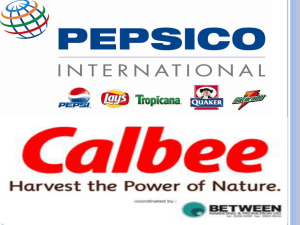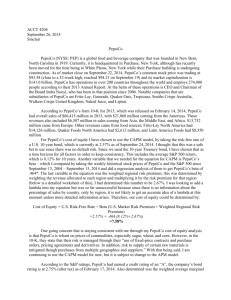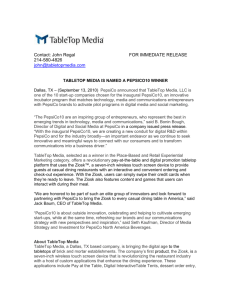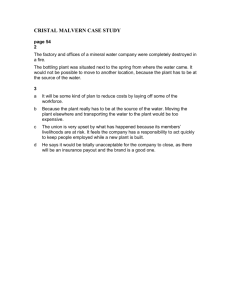Spring - uicaccounting.org
advertisement
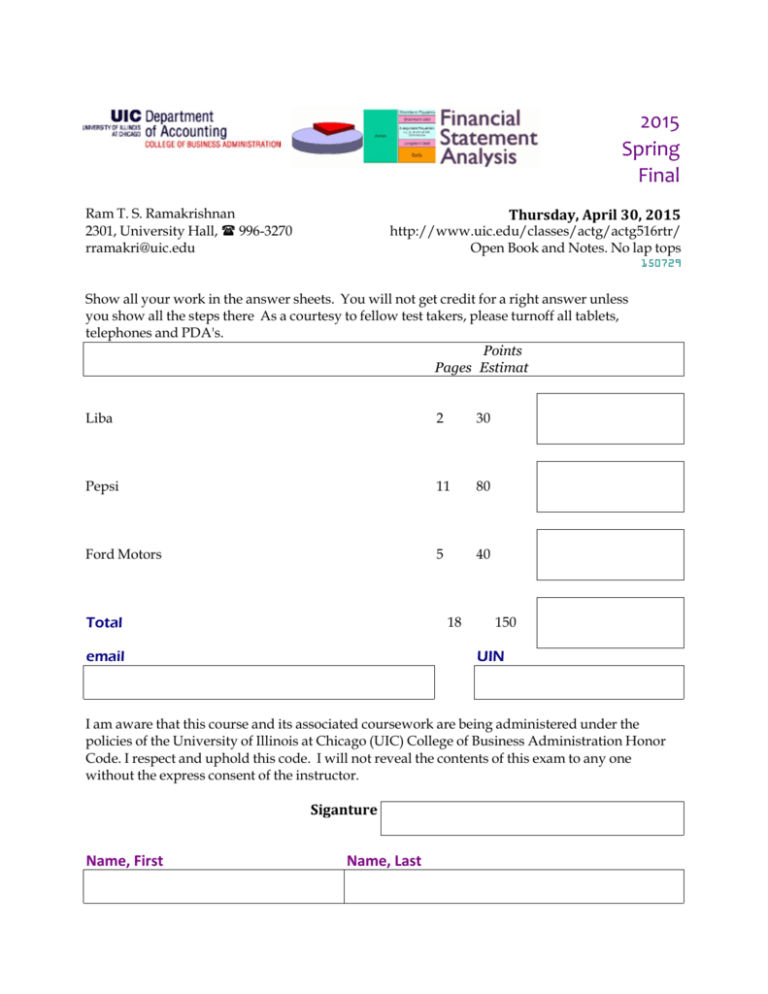
2015 Spring Final Ram T. S. Ramakrishnan 2301, University Hall, ( 996-3270 rramakri@uic.edu Thursday, April 30, 2015 http://www.uic.edu/classes/actg/actg516rtr/ Open Book and Notes. No lap tops 150729 Show all your work in the answer sheets. You will not get credit for a right answer unless you show all the steps there As a courtesy to fellow test takers, please turnoff all tablets, telephones and PDA's. Points Pages Estimat Liba 2 30 Pepsi 11 80 Ford Motors 5 40 18 Total email 150 UIN I am aware that this course and its associated coursework are being administered under the policies of the University of Illinois at Chicago (UIC) College of Business Administration Honor Code. I respect and uphold this code. I will not reveal the contents of this exam to any one without the express consent of the instructor. Siganture Name, First Name, Last 1 of 2 LIBA Details of Liba Inc., a US company's investment activities in Rekhi Inc are as follows: Shares Price Jan 05, 07 Purchased 120,000 Dec 31, 07 Date Activity $32.00 $31.00 Jan 17, 08 Sold Dec 31, 08 $28.00 121129 25,000 Year Ending Dec 31, • Earnings per share for Rekhi Inc. • Dividend per share for Rekhi Inc. for stockholders of record on 08 $0.60 7 $0.50 $0.20 $0.20 The company can choose any of the following four mentods to account for its investment in Rekhi Inc. • Held to maturity • Available for sale • Trading • Equity Questions 1 Under each of the four methods, compute the carrying value of Liba Inc.'s investment in Rekhi on Dec 31, 08. 2 3 2 of 2 Under each of the four methods, compute the income from Liba Inc.'s investment in Rekhi for the year ending Dec 31, 08. Suppose Liba uses the available for sale method. What will be the balance in the "Other Comprehensive Income" account on Dec 31, 08? LIBA Pepsico 1 Extracts from the 10-K report filed by PepsiCo in 2003 are given below. PepsiCo, Inc. was incorporated in Delaware in 1919 and was reincorporated in North Carolina in 1986. When used in this report the terms “we,” “us,” “our” and the “Company” mean PepsiCo and its divisions and subsidiaries. Our Divisions We are a leading, global snack and beverage company. We manufacture, market and sell a variety of salty, convenient, sweet and grain-based snacks, carbonated and noncarbonated beverages and foods. We are organized in six divisions: • Frito-Lay North America, • Frito-Lay International, • Pepsi-Cola North America, • Gatorade/Tropicana North America, • PepsiCo Beverages International, and • Quaker Foods North America. Our North American divisions operate in the United States and Canada. Our international divisions operate in over 175 countries, with our largest operations in Mexico and the United Kingdom operations in Mexico and the United Kingdom The financial statements of the company for the year ending December 28 2002 are given below. Selected footnotes are attached. Consolidated Statement of Income PepsiCo, Inc. and Subsidiaries Fiscal years ended December 28, 2002, December 29, 2001 in millions except per share amounts Net Sales 2002 25,112 2001 26,112 11,497 8,523 138 224 20,382 12,397 8,523 138 224 21,282 Operating Profit 4,730 4,830 Bottling equity income Interest expense Interest income Income before Income Taxes Provision for Income Taxes Net Income 280 (178) 36 4,868 1,555 3,313 280 (178) 36 4,968 1,655 3,313 Cost of sales Selling, general and administrative expenses Amortization of intangible assets Merger-related costs Net Income per Common Share Basic 1.890 Diluted 1.850 See accompanying notes to consolidated financial statements. 1.510 1.470 Pepsico 2 Consolidated Balance Sheet PepsiCo, Inc. and Subsidiaries December 28, 2002 and December 29, 2001 (in millions except per share amounts) 2002 ASSETS 2001 Current Assets Cash and cash equivalents Short-term investments, at cost 1,638 207 1,845 2,531 1,342 795 6,513 683 966 1,649 2,142 1,310 752 5,853 7,290 801 4,418 2,611 1,841 23,474 6,876 875 3,966 2,871 1,254 21,695 Short-term obligations Accounts payable and other current liabilities Income taxes payable Total Current Liabilities 562 4,998 492 6,052 354 4,461 183 4,998 Long-Term Debt Obligations Other Liabilities Deferred Income Taxes 2,187 4,226 1,718 2,287 4,126 1,496 Accounts and notes receivable, net Inventories Prepaid expenses and other current assets Total Current Assets Property, Plant and Equipment, net Amortizable Intangible Assets, net Nonamortizable Intangible Assets Investments in Noncontrolled Affiliates Other Assets Total Assets LIABILITIES AND SHAREHOLDERS’ EQUITY Current Liabilities Preferred Stock, no par value Repurchased Preferred Stock Common Shareholders’ Equity Common stock, par value 12/3¢ per share (issued 1,782 shares) Capital in excess of par value Retained earnings Accumulated other comprehensive loss Less: repurchased common stock, at cost (60 and 26 shares, respectively) Total Common Shareholders’ Equity 41 (48) 30 41 (15) 13,464 (1,672) 11,822 30 13 11,519 (1,646) 9,916 (2,524) 9,298 (1,268) 8,648 Total Liabilities and Shareholders’ Equity 23,474 See accompanying notes to consolidated financial statements. 21,581 Pepsico 3 Consolidated Statement of Cash Flows PepsiCo, Inc. and Subsidiaries Fiscal years ended December 28, 2002, December 29, 2001 (in millions) 2002 Operating Activities 2001 Net income 3,313 Adjustments to reconcile net income to net cash provided by operating activities Depreciation and amortization 1,112 Merger-related costs 224 Other impairment and restructuring charges Cash payments for merger-related costs and other restructuring (123) charges Pension plan contributions (820) Bottling equity income, net of dividends (222) Deferred income taxes 288 Deferred compensation–ESOP – Other noncash charges and credits, net 263 Changes in operating working capital, excluding effects of acquisitions and dispositions Accounts and notes receivable (260) Inventories (53) Prepaid expenses and other current assets (78) Accounts payable and other current liabilities 426 Income taxes payable 278 Net change in operating working capital 313 2,662 Other 279 4,627 8 3,820 (1,437) 89 (351) 376 (1,324) (62) 833 (14) 39 (527) (2,537) 2,078 (41) (2,256) 11 (353) 324 (573) 707 (809) 40 (1,041) (2,158) 788 (483) (397) (994) (1,716) Net Cash Provided by Operating Activities 1,082 356 31 (273) (446) (103) 162 48 209 7 (75) (6) (236) 394 84 Investing Activities Capital spending Sales of property, plant and equipment Acquisitions and investments in noncontrolled affiliates Divestitures Short-term investments, by original maturity More than three months–purchases More than three months–maturities Three months or less, net Snack Ventures Europe consolidation Net Cash Used for Investing Activities (432) Financing Activities Proceeds from issuances of long-term debt Payments of long-term debt Short-term borrowings, by original maturity More than three months–proceeds More than three months–payments Three months or less, net Cash dividends paid Share repurchases–common Pepsico 4 Share repurchases–preferred Quaker share repurchases Proceeds from reissuance of shares Proceeds from exercises of stock options (32) 456 (3,179) Net Cash Used for Financing Activities Effect of exchange rate changes on cash and cash equivalents (10) (5) 524 623 (1,919) 34 Net Increase/-Decrease) in Cash and Cash Equivalents 955 Cash and Cash Equivalents, Beginning of Year 683 Cash and Cash Equivalents, End of Year 1,638 See accompanying notes to consolidated financial statements. (355) 1,038 683 Notes to Consolidated Financial Statements Note 1–Basis of Presentation and Our Divisions Basis of Presentation Our financial statements include the consolidated accounts of PepsiCo, Inc. and the affiliates that we control. In addition, we include our share of the results of certain other affiliates based on our ownership interest. We do not control these other affiliates as our ownership in these other affiliates is generally less than fifty percent. Our share of the net income of noncontrolled bottling affiliates is reported in our income statement as bottling equity income. See Note 8 for additional information on our noncontrolled bottling affiliates. Our share of other noncontrolled affiliates is included in division operating profit. As a result of changes in the operations of our European snack joint venture, Snack Ventures Europe (SVE), we determined that effective in 2002, consolidation was required. Therefore, SVE’s results of operations are consolidated with PepsiCo in 2002. Intercompany balances and transactions are eliminated. Note 6 – Pension and Retiree Medical Plans Our pension plans cover full-time U.S. employees and certain international employees. Benefits are determined based on either years of service or a combination of years of service and earnings. U.S. employees are also eligible for medical and life insurance benefits (retiree medical) if they meet age and service requirements and qualify for retirement benefits. We use a September 30 measurement date. Prior service costs are amortized on a straight-line basis over the average remaining service period of employees expected to receive benefits. For additional unaudited information on our pension and retiree medical plans and related accounting policies and assumptions, see “ Our Critical Accounting Policies” in Management’s Discussion and Analysis. Weighted average pension assumptions Liability discount rate Expected return on plan assets Rate of salary increases 2002 6.70% 9.10% 4.40% 2001 7.40% 9.80% 4.60% 2000 7.70% 9.90% 4.50% Pepsico 5 Note 8–Noncontrolled Bottling Affiliates Our most significant noncontrolled bottling affiliates are The Pepsi Bottling Group (PBG) and PepsiAmericas (PAS). These affiliates account for over 40% of our worldwide bottler case sales. The Pepsi Bottling Group In addition to approximately 38% of PBG’s outstanding common stock that we own at year-end 2002, we own 100% of PBG’s class B common stock and approximately 7% of the equity of Bottling Group, LLC, PBG’s principal operating subsidiary. This gives us economic ownership of approximately 42% of PBG’s combined operations. PBG’s summarized financial information is as follows: 2002 1,737 8,290 10,027 2001 1,548 6,309 7,857 Our investment 1,248 6,607 348 8,203 884 1,081 4,856 319 6,256 762 Net sales Gross profit Operating profit Net income 2002 9,216 4,215 898 428 2001 8,443 3,863 676 305 Current assets Noncurrent assets Total assets Current liabilities Noncurrent liabilities Minority interest Our investment in PBG was $118 million higher than our ownership interest in their net assets at year-end 2002. Based upon the quoted closing price of PBG shares at year-end 2002, the calculated market value of our shares in PBG, excluding our investment in Bottling Group, LLC, exceeded our investment balance by approximately $1.9 billion. Related Party Transactions Our significant related party transactions involve our noncontrolled bottling affiliates. We sell concentrate to these affiliates that is used in the production of carbonated soft drinks and noncarbonated beverages. The sale of concentrate is reported net of bottler funding. We also sell certain finished goods to these affiliates and we receive royalties for the use of our trademark for certain products. For further unaudited information on these bottlers, see “ Our Customers” in Management’s Discussion and Analysis. These transactions with our bottling affiliates are reflected in the Consolidated Statement of Income as follows: Net sales Selling, general and administrative expenses 2002 3,455 83 2001 2,262 57 2000 1,978 5 As of December 28, 2002, the receivables from these bottling affiliates were $126 million and payables to these affiliates were $122 million. As of December 29, 2001, the receivables from these bottling affiliates were $119 million and payables to these affiliates were $108 million. Such amounts are settled on terms consistent with other trade receivables and payables. See Note 9 regarding our guarantee of certain PBG debt. Pepsico 6 Note 9–Debt Obligations and Commitments Long-Term Contractual Commitments and Off-Balance Sheet Arrangements Payments Due by Year Total Less than 1 Year 1-3 Years Long-term contractual commitments (a) Long-term debt obligations (b) Non-cancelable operating leases Purchasing commitments Capital equipment commitments Marketing commitments Other commitments 2,187 526 3,307 34 251 31 6,336 129 773 34 75 23 1,034 3-5 Years More than 5 Years 603 169 1,006 115 8 1,901 699 91 569 885 137 959 52 9 1,411 1,990 (a) Reflects non-cancelable commitments as of December 28, 2002 based on year-end foreign exchange rates (b) Excludes current maturities of long-term debt of $485 million which are classified within current liabilities. Long-term contractual commitments, except for our long-term debt obligations, are not recorded in our Consolidated Balance Sheet. Non- cancelable purchasing, capital equipment and marketing commitments are in the normal course of our business for our projected needs. Our non- cancelable capital equipment commitments primarily relate to our new concentrate plant in Ireland. As bottler funding is negotiated on an annual basis, these commitments are not reflected in our long-term contractual commitments. See Note 8 regarding our commitments to noncontrolled bottling affiliates. Off-Balance Sheet Arrangements It is not our business practice to enter into off-balance sheet arrangements nor is it our policy to issue guarantees to our bottlers, noncontrolled affiliates or third parties. However, certain guarantees were necessary to facilitate the separation of our bottling and restaurant operations from us. In connection with these transactions, we have guaranteed $2.3 billion of Bottling Group, LLC’s long-term debt through 2012 and $68 million of YUM! Brand’s, Inc. (YUM) outstanding obligations, primarily property leases. The terms of our Bottling Group, LLC debt guarantee are intended to preserve the structure of PBG’s separation from us and our payment obligation would be triggered if Bottling Group, LLC failed to perform under these debt obligations or the structure significantly changed. Our guarantees of certain obligations ensured YUM’s continued use of these properties. These guarantees would require our cash payment if YUM failed to perform under these lease obligations Pepsico 7 121212 Required In answering the following questions, combine the line items of PepsiCo statements into groups that correspond to line items that are reported in note 8. Compute the answers only for year ending 28-Dec-02. Ignore note 9 in answering questions 1 to 4. Do not use averages for any ratios from balance sheets. 1 Compute the following ratios for PepsiCo using figures in the reported statements. Do not use averages for denominator, use only Dec 28, 2002 data. Current ratio. a b Debt to equity. c Operating income to sales. d Return on assets (After tax). e Times interest Earned f Return on Equity Pepsico 8 2a Prepare a pro forma Dec 28, 2002, balance sheet for PepsiCo with its unconsolidated equity companies fully consolidated. Pepsico 9 2b Prepare a pro forma income statement for the year ending Dec 28, 2002, for PepsiCo with its unconsolidated equity companies fully consolidated. Pepsico 10 a Compute the ratios listed in 1 for PepsiCo using the pro forma statements prepared under 2. Current ratio. b Debt to equity. c Operating income to sales. d Return on assets (After tax). e Times interest Earned f Return on Equity 3 Pepsico 11 4 Which ratios worsened due to full consolidation ? Why? Why do you think PepsiCo did not consolidate all its affiliates on its financial statements ? 5 Consider note 9. Will the estimate of the risk profile of PepsiCo change if you consider the information in Note 9. Recompute the ratios listed in 1 for PepsiCo. Note that all ratios will not change with the new information. List the assumptions you make in your analysis. 1 of 5 Ford Motors Ford Motor Company engages in the manufacture and distribution of automobiles worldwide. It manufactures and sells cars and trucks, and related service parts under Aston Martin, Ford, Jaguar, Land Rover, Lincoln, Mazda, Mercury, and Volvo brand names. Ford Motor Credit’s primary financial products comprise retail and wholesale financing, and other financing, such as making loans to dealers for working capital, improvements to dealership facilities, and the acquisition and refinancing of dealership real estate. The company operates in approximately 200 markets across 6 continents. Ford Motor was founded in1903 and is based in Dearborn, Michigan. The quarterly financial statements for the quarter ending 9/30/2006 and portions of the financial statements for the fiscal year ending 12/31/2005 are attached. [For Income Statement items, the last 12 monh figures should ber used.] Stock performance 2 of 5 Income Statement Ford Motors Third Quarter (unaudited) First Nine Months Restated - Restated - See Note 2 2006 Sales and revenues Automotive sales Financial Services revenues Total sales and revenues Costs and expenses Automotive cost of sales Selling, administrative and other expenses Interest expense Financial Services provision for credit and insurance losses Total costs and expenses Automotive interest income and other non-operating income/(expense), net Automotive equity in net income/(loss) of affiliated companies Gain on sale of The Hertz Corporation ("Hertz") Income/(loss) before income taxes Provision for/(benefit from) income taxes Income/(loss) before minority interests Minority interests in net income/(loss) of subsidiaries Income/(loss) from continuing operations Income/(loss) from discontinued operations (Note 4) Income/(loss) before cumulative effects Cumulative effects of changes in accounting methods Net income/(loss) 2005 See Note 2 2006 2005 32,556 4,554 37,110 34,656 107,356 5,854 12,449 40,510 119,805 112,778 153,503 17,793 23,586 130,571 177,089 37,554 4,496 1,936 97 33,471 110,340 5,983 13,730 2,157 6,330 182 193 105,786 144,944 18,181 24,652 6,287 7,643 350 483 44,083 41,793 130,593 130,604 177,722 555 307 1,080 1,111 61 133 345 259 (6,357) (1,157) (5,200) 48 (5,248) (5,248) (843) (314) (529) 54 (583) 7 (576) (9,363) (2,499) (6,864) 126 (6,990) 2 (6,988) 1,337 (328) 1,665 196 1,469 45 1,514 Average number of shares of Common and Class B stock outstanding Amounts Per Share of Common and Class B Stock Basic income/(loss) Income/(loss) from continuing operations Income/(loss) from discontinued operations Cumulative effects of changes in accounting principles Net income/(loss) Diluted income/(loss) Income/(loss) from continuing operations Income/(loss) from discontinued operations Cumulative effects of changes in accounting principles Net income/(loss) Cash dividends Twelve Months Year 2005 1,249 285 1,095 1,996 (512) 2,508 280 2,228 47 2,275 (251) 2,024 1,846 -2.79 -0.31 -3.73 0.8 0.02 1.21 0.03 -0.14 1.1 -2.79 -0.31 -3.73 0.82 -2.79 -0.31 -3.73 0.76 0.03 -2.79 -0.31 -3.73 0.79 1.14 0.02 -0.11 1.05 0.05 0.1 0.25 0.3 0.4 3 of 5 Balance Sheet Ford Motors 9/30/06 (unaudited) Assets Cash and cash equivalents Marketable securities Loaned securities Other receivables, net Net investment in operating leases Retained interest in sold receivables Inventories (Note 6) Current assets 12/31/05 , Restated 25,511 14,552 564 8,004 30,943 1,073 11,997 92,644 28,406 10,672 3,461 8,536 27,099 1,420 10,271 89,865 2,828 106,685 37,844 4,197 6,396 16,871 267,465 2,579 105,975 40,676 5,880 5,945 5 18,534 269,459 Liabilities and Stockholders Equity Payables Accrued liabilities and deferred revenue Debt Deferred income taxes Current liabilities 22,738 28,733 978 2,774 55,223 22,910 29,700 977 5,660 59,247 Accrued liabilities and deferred revenue Long term debt Minority interests 48,632 153,432 1,015 43,347 152,301 1,122 18 1 4,579 (785) (258) 5,608 9,163 267,465 18 1 4,872 (3,680) (833) 13,064 13,442 269,459 Equity in net assets of affiliated companies Finance receivables, net Net property Deferred income taxes Goodwill and other intangible assets (Note 9) Assets of discontinued/held-for-sale operations Other assets Total assets Stockholders equity Capital stock Common Stock, par value $0.01 per share (1,837 million shares issued) Class B Stock, par value $0.01 per share (71 million shares issued) Capital in excess of par value of stock Accumulated other comprehensive income/(loss) Treasury stock Retained earnings Total stockholders equity Total liabilities and stockholders equity 4 of 5 Ford Motors [For Income Statement items, the last 12 monh figures should ber used.] 1 Compute the Z-score for Ford on two dates: a b 9/30/2006 12/31/2005 5 of 5 Ford Motors 2 Based on those Z-scores what can you say about the probability of Ford going bankrupt ? What are the main reasons for the worsening of the z-score over the nine months? 3 Use two ratios to predict the ratings for Ford debt on the two dates. Do not use information from the accompanying article. Justify you ratings based on S & P key industrial financial ratios. 4 A recent article which describes Ford's attempt to increase its debt is attached. What do you think will happen to the ratings of Ford debt already in the books? How will the new issues be rated - higher or lower than the current debt ratings before the new issues? 5 Mention two possible financial measures that Ford could take to boost its bond ratings.



